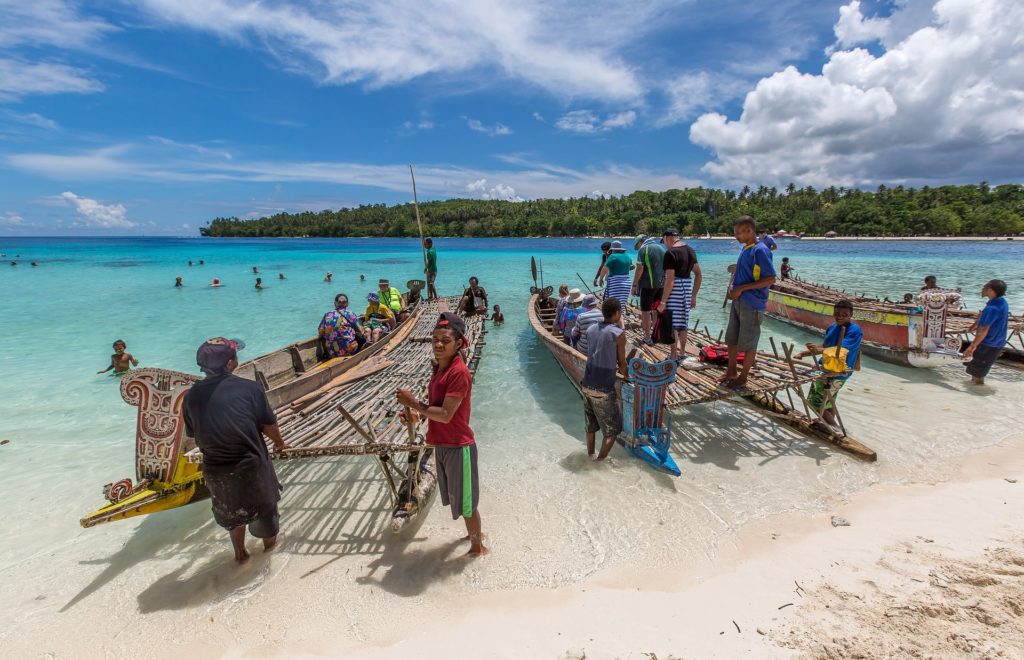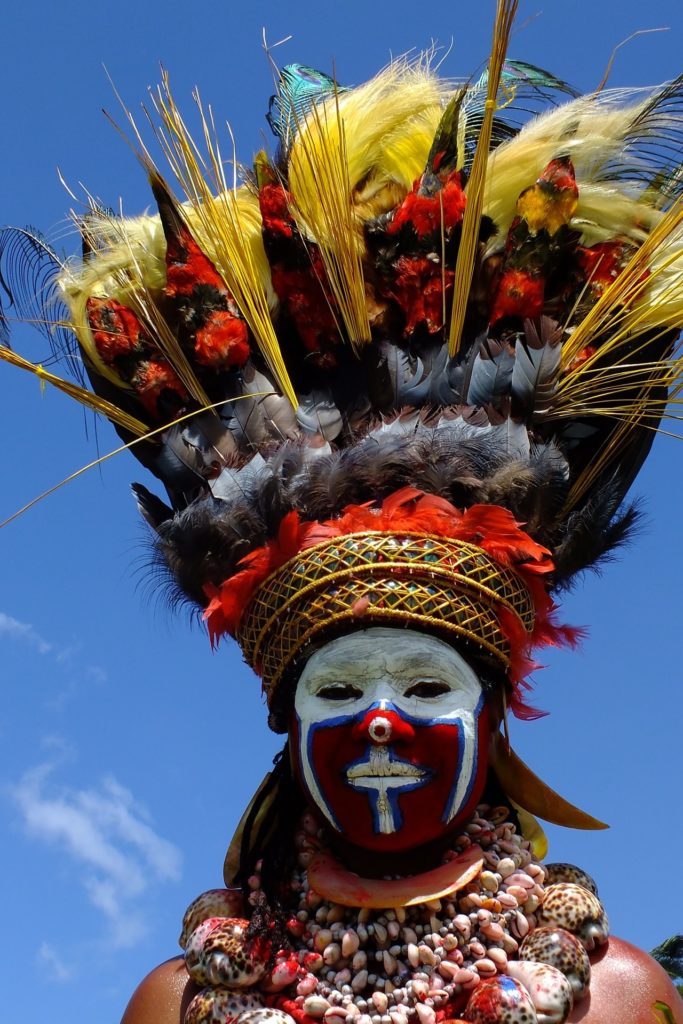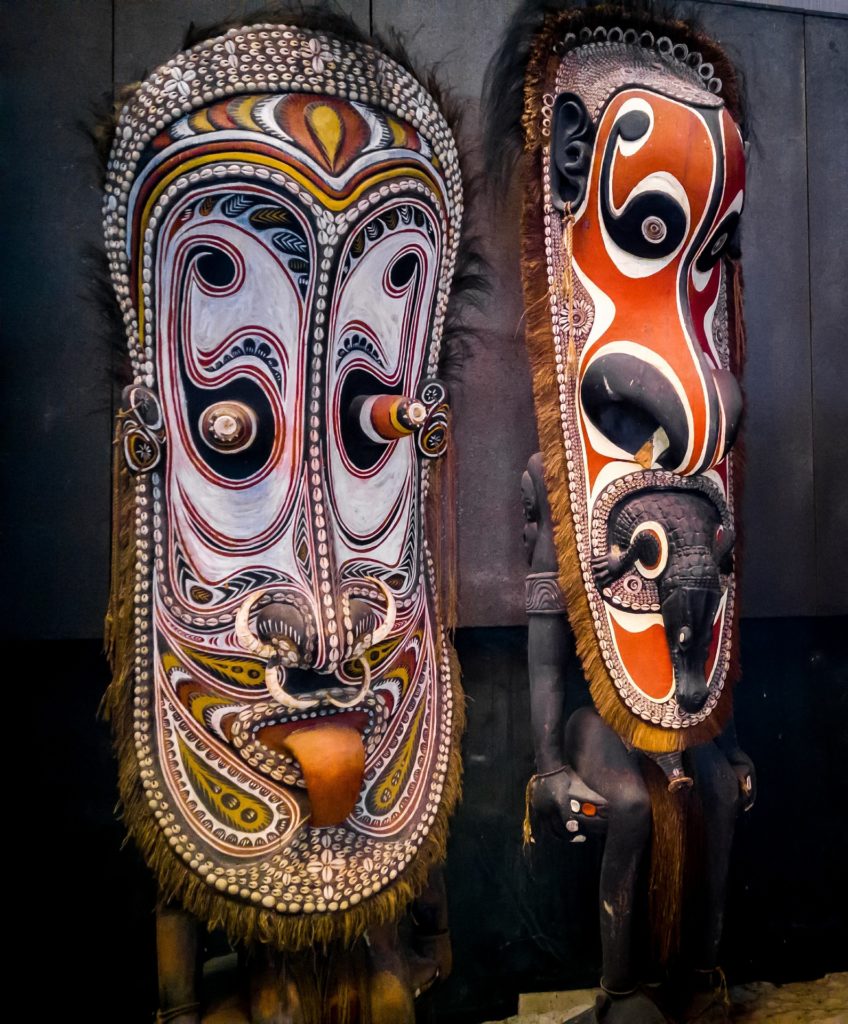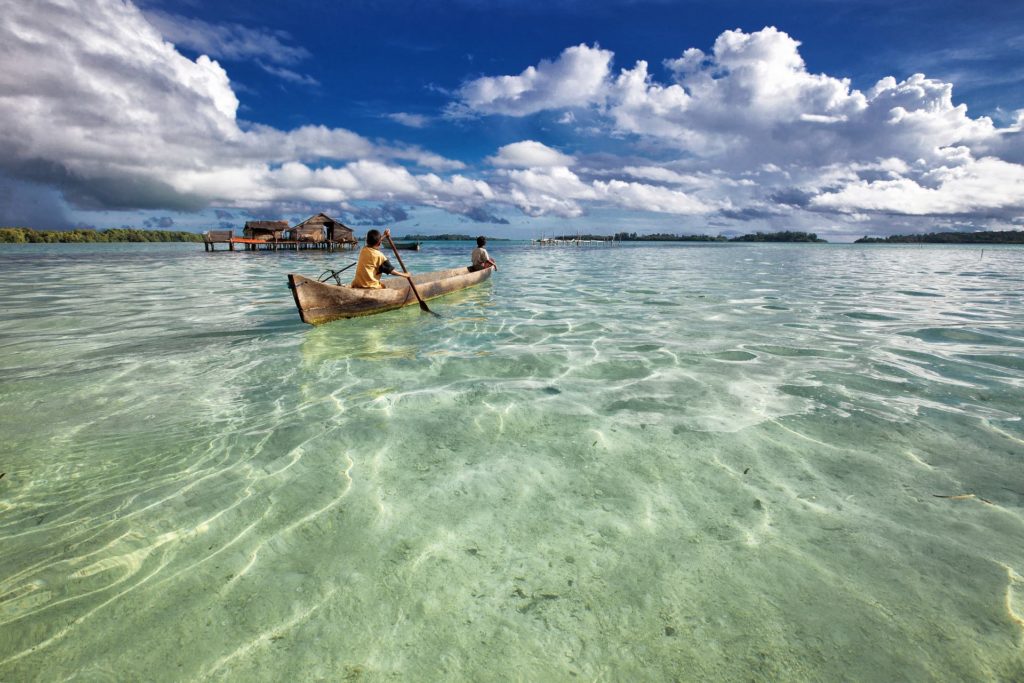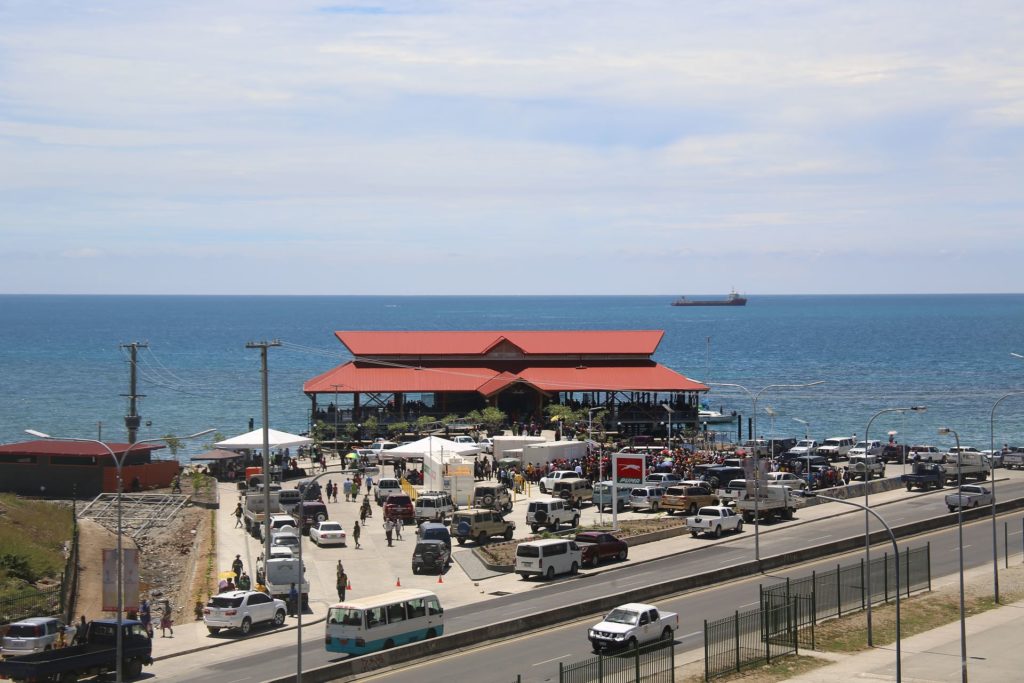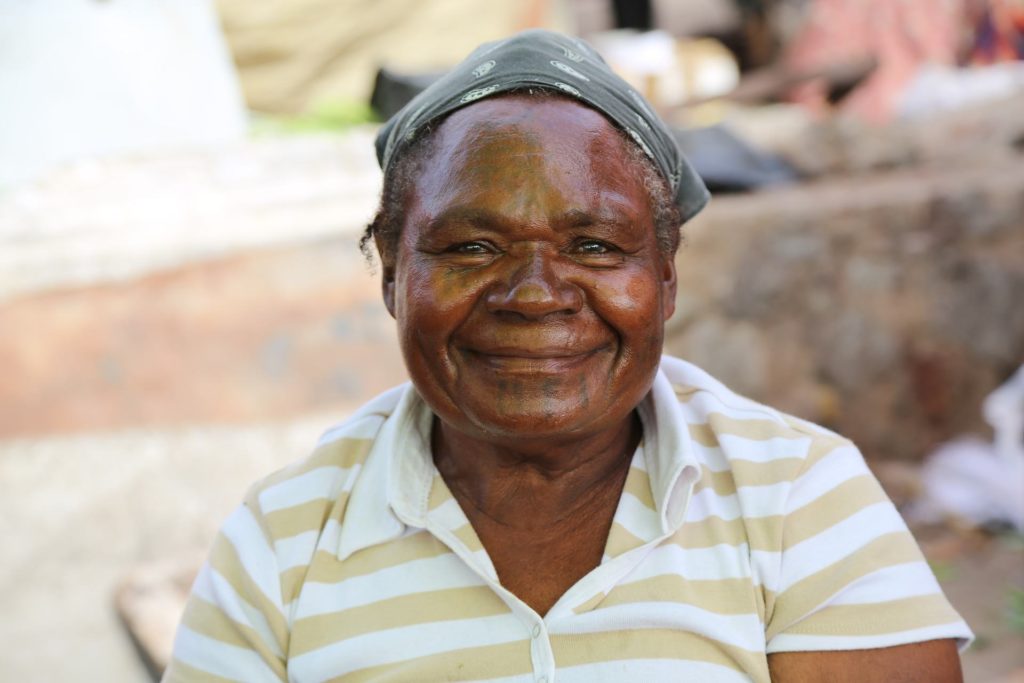Backpacking in Papua New Guinea
Headhunters, tribal festivals, volcanoes – this is what most people associate with Papua New Guinea. But Papua New Guinea is much more than these stereotypes. On the contrary, the country only becomes really exciting when you visit the spots that are still closed to the few tourists anyway. One thing is certain: Whoever sets off for backpacking in Papua New Guinea will experience a real adventure in any case.
Papua New Guinea is an independent island state in the Pacific to which the eastern part of the island New Guinea as well as offshore islands and island groups belong. One of these island groups is the Bismarck Archipelago, which consists of the three main islands, New Ireland, New Britain and Manus as well as other small islands. The western part of New Guinea belongs to Indonesia. Papua New Guinea gained its independence from Great Britain in 1975 and has since been a constitutional monarchy, whose head of state is Queen Elizabeth II. The capital of the country is Port Moresby, the currency of Papua New Guinea is China.
History of Papua New Guinea
The island of New Guinea was divided by the colonial powers as a result of power political games. The Dutch had already claimed the western part of the island in 1828. New Guinea was an important base for the Dutch East India Company. Both Great Britain and the German Empire wanted to take possession of the still “free” eastern part of the island.
The Germans first successfully created facts here. In 1885, however, an amicable agreement was reached on a further division of the eastern part, with the north being placed under German rule as “Kaiser Wilhelm Land” and the south being taken over by the British as the protectorate of British New Guinea. As a result of the loss of World War I, Germany lost its colonial territory. The eastern part of the island was handed over to Australia for administration. The West was annexed by Indonesia in 1962.
The capital of Papua New Guinea, Port Moresby, is almost impressive compared to the conditions in Oceania, where large cities are rather rare. The city has about 360,000 inhabitants. In addition to the official population statistics, the inhabitants of the slums around the capital are also included. The formation of these quarters – and also the high crime rate in the capital – has its main cause in the strong rural exodus.
Since many of those aspiring to the capital cannot find work there, the misery is great. Again and again there are conflicts between members of different ethnic groups. In the meantime, unemployed young people from the slums are sent back to their home villages by the government.
Papua New Guinea Economy
Although Papua New Guinea’s economy is rich in natural resources, which are also mined, it is still dominated by agriculture. A large part of the population lives in subsistence farming. Coffee, cocoa and tea are mined on smaller plantations.
A major problem is the deforestation of the rainforest from which tropical timber is extracted. This poses a massive threat to biodiversity and the entire ecosystem. Moreover, a large part of the deforestation is illegal. The region’s abundant fish stocks are equally exploited.
The overall problem is that the raw materials are being used to overexploit nature – and the people of Papua New Guinea hardly benefit at all from this. The government is doing little to stem the rural exodus, reduce the crime rate and expand the urgently needed education and health system. Despite exports of oil, gold, copper, coffee and wood, the country is therefore not doing particularly well.
Culture in Papua New Guinea
Culturally, Papua New Guinea is one of the most interesting corners of the world. In this country, between 800 and 1000 different ethnic groups, which belong to the Papua peoples, live on only about 500,000 square kilometres. Particularly in the very remote parts of the highlands, they have preserved much of their traditional ways of life to this day. In addition, there are a large number of Melanesians who tend to live in the flatter regions and near the coast. Here, too, the ethnic diversity is great. In addition, there are some other minorities, including some of European origin. Here the colonial history has left its mark on demography.
The linguistic diversity is correspondingly great, as each of these ethnic groups also has its own language. According to statistics, up to 25% of the world’s languages can be found in the island state alone.
The language is for the natives the primary characteristic of their ethnic affiliation. This system is called the Wantok system. The name for it derives from the Tok Pisin word for “same language”, from the English “one talk”. This means members of the same ethnic group. Tok Pidgin can be reasonably understood if you have a very good command of English.
There are some important cultural festivals in Papua New Guinea where the different ethnic groups come together. These are now one of the main tourist attractions on the island. However, this cultural diversity is increasingly overshadowed by the violent clashes between the different groups. In recent years they have increasingly turned Papua New Guinea into a dangerous place to live. During your trip you should always keep this in mind and try to find out in advance where such conflicts are particularly active and which regions should be avoided accordingly.
The Bismarck Archipelago and the whole of Papua New Guinea have a very rich mask culture. Many of these traditional masks from New Ireland and New Britain hang today in ethnological museums around the world. Here you can experience where they have their origin!
Backpacker Budget in Papua New Guinea
Backpacking in Papua New Guinea may be a big adventure – it is also an expensive one. This has a lot to do with the fact that there is hardly any tourist infrastructure. The few foreigners who travel to PNG usually have a large budget and live in the few expensive resorts. Direct contact with the local way of life is then very limited. Primarily cultural shows and nature highlights are watched.
The daily budget is at least 80 € if you limit yourself to cheap food from the markets and stay in simple guesthouses. If you want upscale accommodations and organized travel packages for sightseeing, you will quickly double the price.
You can save something by spontaneously asking families in the villages or churches for accommodation – so to speak couchsurfing without a platform. For unaccompanied women this is certainly not a completely harmless adventure, but in any case good for your wallet. Also, those who mainly rely on yam roots for their food will save a lot of money. Nevertheless: You won’t be able to cancel all flight connections from a trip through PNG, and that alone makes the trip quite expensive.
Rental car in Papua New Guinea
Rental cars are not available in Papua New Guinea, which is also due to the fact that the roads beyond the larger cities end quickly. You can only get there on foot, by boat or by plane.
Public transport in Papua New Guinea
In Papua New Guinea there are only a few roads and hardly any traffic infrastructure. The best means of transport are therefore often your own feet – alternatively there are also some domestic flights, which are expensive. Other alternatives are PMVs (Public Motor Vehicles) and boats.
Buses in Papua New Guinea
The best way to get from A to B in Papua New Guinea is with the so-called PMVs, the Public Motor Vehicles – at least in the few spots where there are actually roads. These are vehicles of all kinds and equipment that travel on defined routes and transport passengers. Driving PMVs is extremely economical. In principle, it is sufficient to arrive at one of the stopping points and wait until a vehicle arrives. In more remote, rural areas, however, the routes are only operated once a day. So it’s better to find out in advance when the departure is, so that you don’t wait too long…
Usually, you can recognize PMVs by the fact that many people are crammed together in a confined space. If you want to get off first, call the driver to “Stop, driver! For women travelling alone it can be problematic to use PMVs. If you are travelling alone as a woman, you should try to find a place next to or between other women.
Rail travel in Papua New Guinea
There is no railway network in New Guinea.
Ferries in Papua New Guinea
Boats run for example along the coast and thus save long marches. The Sepik, the big river on the island of New Guinea, can also be reached by boat in order to get inland. The Federal Foreign Office explicitly warns against the use of these boats as they do not meet the western standards; this is certainly correct. Nevertheless, one can assume that the local population is equipped with some expertise. Of course, everyone has to assess the risk for himself. Usually they are not official ferries, but cargo ships that take passengers with them for a small fee.
Flight connections in Papua New Guinea
There are relatively many domestic flights with Air Niugini or Air PNG, but the tickets are quite expensive, and almost all flights are connections via Port Moresby. For the way to the Bismarck archipelago, however, the flight connections to Rabaul or Kavieng are definitely the best option.
Backpacker Route in Papua New Guinea
Papua New Guinea is probably one of the last great adventures for any backpacker. Really concrete route recommendations can hardly be given here, because if you don’t want to be on an organized tour, there are hardly any possibilities to plan details in advance. Rather, you should make a rough list of what you would like to see – and then ask yourself on the spot.
Even if Papua New Guinea is considered dangerous, the people are extremely helpful and nice. The best thing to do when you arrive in Port Moresby is to try to find a first contact, for example through your first accommodation, which will help you a bit with the planning. And then you simply go step by step and see what is possible.
On organised tours – which are rare anyway – only selected tribal festivals are visited, for example in Rabaul (New Britain). Occasionally there are nature excursions, trekkings (especially Kokoda Track) or trips to the big volcanoes (Tavurvur on New Britain). If you want to see a little bit of Papua New Guinea, but don’t dare to do the big adventure, you should definitely stick to such a tour. But then you’ll quickly be at a cost of several thousand Euros – without travel, of course.
Here are two suggestions on how you can structure your trip to Papua New Guinea if you are an individual traveller.
Papua New Guinea for those in a hurry (approx. 15-20 days)
- 2-4 days: Port Moresby
- Kokoda Track (return flight from Kokoda to Port Moresby)
- 2 days Mount Hagen
- 3-4 days Lae
- 5 days Madang
- 1 day Port Moresby
Papua New Guinea intensive (approx. 30-40 days):
- 2-4 days: Port Moresby (approach usually from Australia)
- 2 days Mount Hagen
- 7-10 days central highlands (Kokoda Track, Mount Wilhelm)
- 3-4 days Lae
- 7 days Madang
- 5-7 days New Britain (with Rabaul and Mt. Tavurvur)
- 5-7 days New Ireland (with cavieng)
- 4-5 days Manus
- 1 day Port Moresby
Travel times in Papua New Guinea
Papua New Guinea is topologically characterized by great differences in altitude, and accordingly there are great differences between the climate in the highlands and on the coast. The months of July to September are ideal for Port Moresby and Madang. It is dry and the temperatures regularly drop below 30°C. Also good travel months are May/June and October/November. In the mountain regions, however, it is quite cold in winter (July to September). Generally there is snow all year round in the highest regions. The best travel time for you depends on what you have in mind.
Backpacker Trips & Tips in Papua New Guinea
Papua New Guinea is generally considered to have read “hot plaster” with a high street crime rate. Single travellers are particularly easily affected. Sometimes the readiness to use violence is quite high; beyond the bigger cities (above all Port Moresby, Lae, Mount Hagen) this is however different – here the population lives very rural and is generally helpful and friendly.
Unfortunately, you have to reckon with the fact that there are sometimes violent clashes between different tribes and ethnic groups, in which armed force is also used. Occasionally trekking groups have also fallen between the fronts here.
In any case, you should always make sure that the route you have imagined is just reasonably safe.
Of course, everyone has to assess these risks for themselves. But you shouldn’t believe every horror story about Papua New Guinea either. If you keep up to date and try to avoid areas where there is an increase in clashes between tribal groups at any given time, you are well served.
Also, a visit to Bougainville Island should not be on your itinerary, as there are some violent rebel groups here; you’ll need a special permit anyway.
Backpacker Highlights in Papua New Guinea
For trekking enthusiasts in Papua New Guinea there is the popular Kokoda Track. It leads from Port Moresby to Kokoda inland – and can be continued to Gona on the other side of the island.
It is also possible to fly back from Kokoda by plane. This “half way” is 96 km long and can be hiked in about 6 days. It leads up to over 2000 meters of altitude – due to the altitude and the climatic conditions it is strongly recommended to arrive well trained.
The Kokoda Track is actually a bush path, but it was used for military purposes during the 2nd World War. Today it is one of the main tourist attractions of the country. Accordingly, there are relatively many travel groups and some unfortunately not very authentic cultural performances. But one is rewarded with impressive views – and hikes quite deep into the jungle.
Whoever makes it to the Bismarck archipelago: here is one of the main attractions of the volcano Tavurvur, which is located not far from the city of Rabaul. Those who like can climb up to the volcano, right through the cooled lava fields of the last big eruptions in 1994 and 2014. Still today, the volcano is very active, so that during a hike to the Caldera, you will surely be able to observe some spectacular natural spectacles.
Admittedly: Those who swim in the sea may not normally book a beach holiday in Papua New Guinea. Nevertheless, PNG has some beautiful beaches – and the underwater world is very diverse and interesting, which makes Papua New Guinea a popular destination for divers.
Backpacker Insider Tips in Papua New Guinea
It doesn’t take much explanation: Papua New Guinea is an insider tip in itself, even among backpackers. But there is not necessarily “the” ultimate insider tip what one must have seen or experienced on the island.
Many tourists stick to the traditional festivals, Sing-sings, at which different ethnic groups meet and show their traditional culture. The most famous is certainly the Goroka show in September, which also attracts numerous tourists from home and abroad. Without a doubt, it is worthwhile to have visited such a festival once; but the real charm of Papua New Guinea lies in the fact that it is still so poorly developed as far as tourism is concerned that one can still get to know a lot of original country life in remote areas.
Here you come into direct contact with the people and are almost always warmly welcomed. It is therefore worthwhile to simply walk out into the villages away from the “highlights” or to take a ferry and spend a few days there.
The Bismarck archipelago with the main islands New Britain, New Ireland and Manus is here again particularly recommendable. In certain areas the traditional mussel money is still used. In any case, there is still a lot to learn about the traditional ways of life – even though traditional clothing is almost exclusively worn at parties today. By the way: As far as WLAN is concerned, there is almost no such thing as WLAN. When backpacking in Papua New Guinea you are literally “off the grid”.
Backpacker accommodations in Papua New Guinea
Hostels and guesthouses can be found in many of the larger towns, but they are relatively expensive – and the quality of the accommodation does not always justify the price. For a very simple accommodation you have to calculate at least 30 € per night.
There are some middle and upper class hotels that you can book on the internet. But here you will find prices between 80 and 150 €. In addition, most of these hotels are either located in Port Moresby or are resorts in the bathing and diving resorts.
A very cheap, unconventional alternative is to stay overnight in families or churches. The comfort is not always huge, but often comfortable enough – and very gentle on your wallet. In addition, you come into direct contact with the local population and experience local life up close – what more could you ask for?
Food & Drinks in Papua New Guinea
The best experiences in Papua New Guinea will probably not be the culinary ones. From a culinary perspective, PNG is rather one-sided and barren. Rice, yams, taro and sago are the main foods consumed. There are also some fruits that are widely spread, meat and fish are usually added to the food only in small quantities. In the bigger cities there are some fast food shops, but they are not really worth a visit.
The cost of food depends heavily on how you eat. Those who buy at the local markets and stick to the regional basic foods yams, rice and canned fish get off very cheaply. You should make do with 10 to 15 € then actually. On the other hand, you can of course treat yourself to a glass of Nutella, but that costs 15 €.
Food in Papua New Guinea
The majority of Papua New Guinea’s inhabitants live in subsistence farming. Accordingly, people eat what is cultivated – and the cuisine is not particularly varied.
The urban population also predominantly consumes simple meals, even though fast food is also consumed here and there is a slight influence of the cuisines of Southeast Asia.
The national dish is Mumu, named after the earth oven of the same name in which the dishes were traditionally prepared. Mumu is a kind of stew made of pork, sweet potatoes, rice and vegetables, which is not cooked originally, but cooked in an earth oven.
Traditionally there are three meals, whereby breakfast is the least important and is sometimes simply replaced by coffee. Lunch is eaten together with the family. The lunch consists of several “courses” and can last several hours. In the city, however, it is often shorter because people are bound to a fixed work rhythm. In the evening in the rural areas one is usually the remnants of lunch, while in the city the dinner – due to the other rhythm of life – gets a stronger weight.
Drinking in Papua New Guinea
Among the most popular drinks are kava, a soft drink obtained from the root of the kava plant, and coconut water (Kulau). Coffee is grown and drunk in Papua New Guinea. Beer is the most popular alcoholic drink.
Backpacker Visa and Vaccinations in Papua New Guinea
For the entry to Papua New Guinea a visa is required for German citizens, which is issued however completely problem-free with the entry in Port Moresby. The visa is free of charge and entitles the holder to enter the country for up to 60 days. This visa is only valid for tourist purposes. All other visas must be applied for in advance at the Embassy of Papua New Guinea.
According to the entry regulations of the Federal Foreign Office, the following documents are accepted as travel documents:
- Passport: Yes
- Temporary passport: unknown
- Identity card: No
- Temporary identity card: No
- Child passport: Yes
You should also check directly with the German Foreign Office for the latest details on entry requirements before your trip.
Medical Information & Vaccinations for Papua New Guinea
There are no vaccination regulations for German travellers entering Papua New Guinea. However, it is advisable to always keep the vaccination protection up to date – as an orientation you should use the vaccination calendar of the Robert Koch Institute.
In addition, you should be vaccinated against hepatitis A and typhoid fever for your trip, and also against hepatitis B, rabies and Japanese encephalitis for longer stays.
A variety of mosquito-borne infectious diseases including malaria, Japanese encephalitis, dengue fever and chikungunya are common in Papua New Guinea. Preventive mosquito protection – day and night – is everything!

